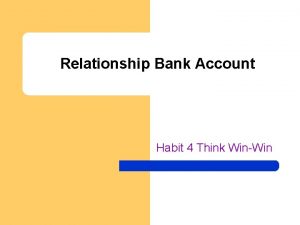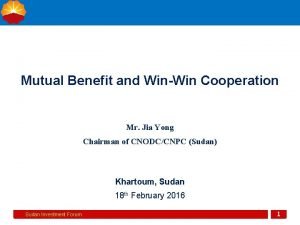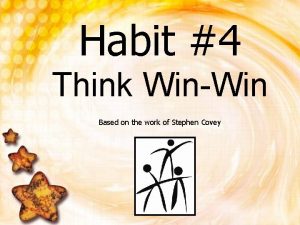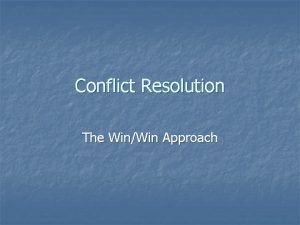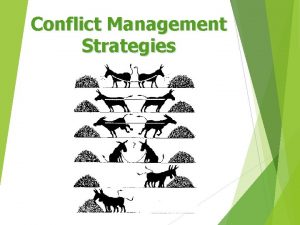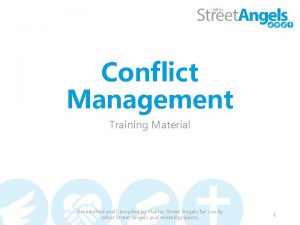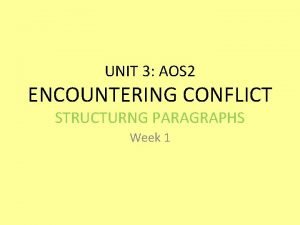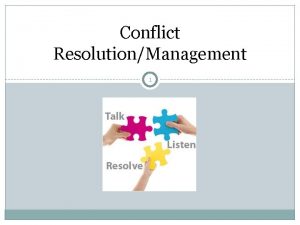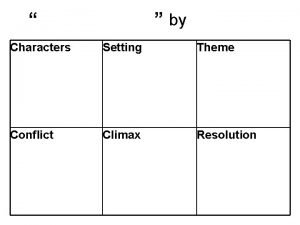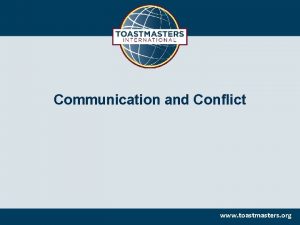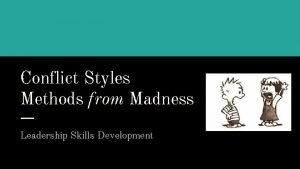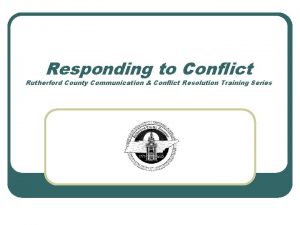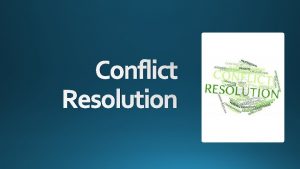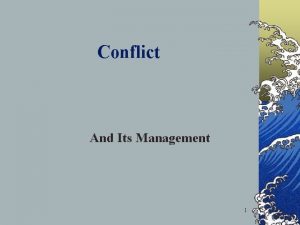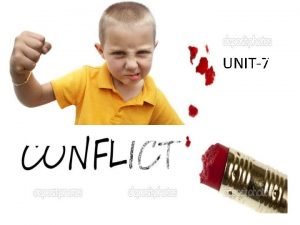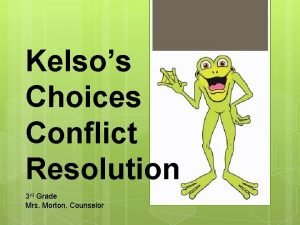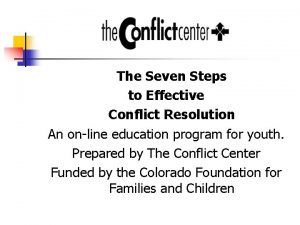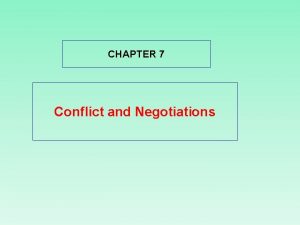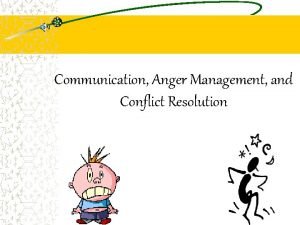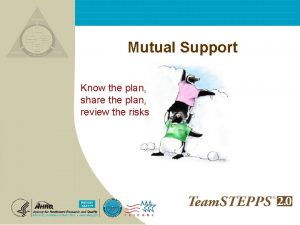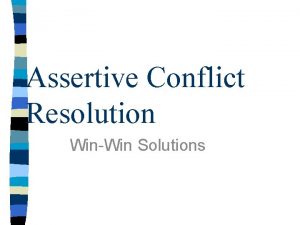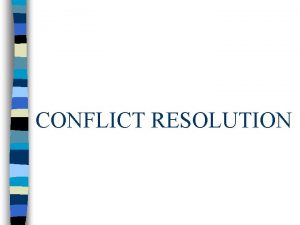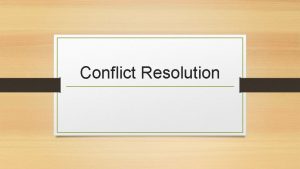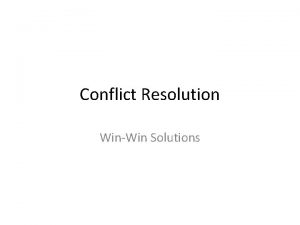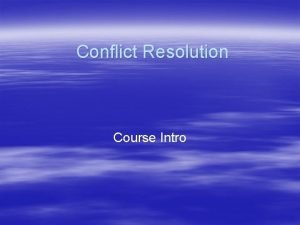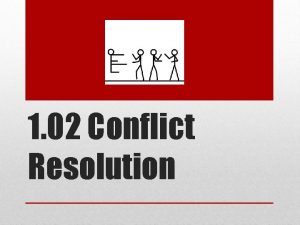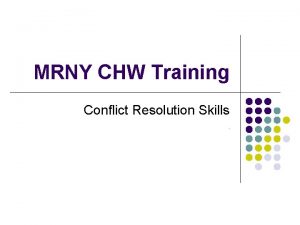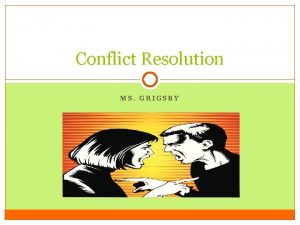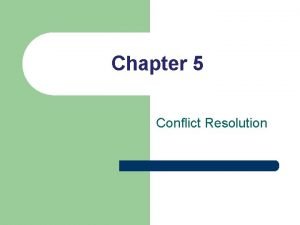Conflict Resolution The WinWin Approach The WinWin Approach







































- Slides: 39

Conflict Resolution The Win/Win Approach

The Win/Win Approach n n n The Handshake Exercise Each student will choose a partner roughly the same size as themselves. Both partners will lock hands in the form of a handshake. You score a point every time you get the other persons hand to your hip. The aim of this exercise is to win as many points as you can. You have 1 minute for this exercise.

The Win/Win Approach n n The Handshake Exercise Who scored more than 30? Who scored less than 20? Who scored less than 10? How did you interpret “you” in the instructions? As an individual, a pair or a group?

The Win/Win Approach n n The Handshake Exercise Did the idea of “winning” imply “losing” as well? Who discussed it with their partner? If you discussed it, what was discussed? Did anybody change strategy during the exercise and if so, why?

The Win/Win Approach n n The Handshake Exercise When we are in conflict with someone else, do we frequently approach it thinking that one person will win and one will lose? Examples of this might be…”I told him”; “I put her in her place”; “I showed him who was boss”; “I didn’t let her get the better of me”; “I got my way”; “I always lose out in these sorts of problems”.

The Win/Win Approach n n The Handshake Exercise In an exercise such as this, it is possible to interpret “win” in a variety of ways and behave accordingly. Problems arise when we transfer a concept of “wining over” to situations where “winning with” would be more beneficial. “Winning over” is about one person winning while the other loses. “Winning with” is about cooperating so that both people obtain what they want or need.

The Win/Win Approach n n The Handshake Exercise A Win/Win approach is a co-operative effort that will maximize the benefits for everyone. A Win/Lose approach is based on competition and is far more likely to result in major differences in benefit to all involved.

The Win/Win Approach n Now we will discuss the concept of Fight and Flight Behaviors when dealing with conflict.

The Win/Win Approach n n n Some examples of Fight behaviors include: Screaming Physical Violence Refusing to listen Manipulation

The Win/Win Approach n n n Some of the main messages and intentions behind Fight behaviors are: I’m right / you’re wrong To blame or punish To threaten I’m OK / you’re not

The Win/Win Approach Fight = I Win / You Lose This is considered an Aggressive Behavior

The Win/Win Approach n n n Some examples of Flight behaviors include: Sulking Crying Avoiding Pretending it hasn’t happened Giving in

The Win/Win Approach n n n Some of the main messages and intentions behind Flight behaviors are: I’m right / you’re wrong To avoid conflict To let the other person win I’m not OK / you are

The Win/Win Approach Flight = I lose / you win This is considered a Passive behavior.

The Win/Win Approach n It is obvious that neither Fight or Flight are optimum tools for handling conflict as someone always loses.

The Win/Win Approach n Now we introduce a slightly different set of behaviors that fall in between Fight and Flight. Lets call them Flow behaviors.

The Win/Win Approach n n n Some examples of Flow behaviors can include: Discussing the issue Listening to others Taking time out Explaining one’s own perspective and needs. Compromising

The Win/Win Approach n n n Some of the main messages and intentions behind Flow behaviors are: There must be a way to solve this. To sort out the problem. To respect others. To make sure everyone is satisfied with the solution I’m OK / you’re OK

The Win/Win Approach Flow = I Win / You Win This is considered an Assertive behavior

The Win/Win Approach n During Fight behavior, the intention, which may be unconscious, is to come down hard on the issue, with little concern for the person.

The Win/Win Approach n During Flight behavior the intention, which may be unconscious, is to protect ourselves rather than deal with the problem. By not confronting, the immediate result is relatively soft on the person.

The Win/Win Approach n During Flow behavior, the intention is to solve the problem while at the same time respecting everyone in the conflict.

The Win/Win Approach n Although flow behaviors seem to have the best outcomes, we often resort to Fight or Flight behaviors. It is important to realize and remember what these behaviors are, so that we can use them to our advantage in dealing with conflict.

The Win/Win Approach n n Here is a little story: There are two probationary mechanics in a break room and only one orange. Both of them want the orange. What could they do?

The Win/Win Approach n n n They decided to compromise, and cut the orange in half. One mechanic went to the juicer and started to squeeze himself a drink, which turned out too small to satisfy. The other mechanic, with some difficulty. Began to grate the rind on his half of the orange to flavor a cake for the upcoming proby dinner. He then threw out the pulp.

The Win/Win Approach n n Both mechanics had only half of the orange, in effect, they could have had the whole orange. Had they talked out the problem, listened to each other and found out what each one wanted and/or needed, the solution would have been more practical for each.

The Win/Win Approach n The key to the Win / Win approach is to explore all of the needs before settling on a solution.

The Win/Win Approach n Compromise is sometimes considered the same as a Win/Win approach. Some of the reasons that we so often use it are:

The Win/Win Approach n n n Compromise It may seem to be the simplest, easiest and fairest thing to do. It means that when we can’t make a bigger pie, at least everyone is sharing what is available. It results in both parties having Some of their needs met.

The Win/Win Approach n n Compromise It does have some disadvantages, such as: It often requires one party to give more, and than they will be less committed to the solution. It may mean that the potential of all options hasn’t been explored. It has been described as an acceptable form of Lose/Lose.

The Win/Win Approach n n Compromise Although compromise has disadvantages, it is sometimes a valuable approach. However, if we settle to quickly for compromise, we can sell ourselves short. It may even be that we decide on a poorer quality solution than we would have if we had adopted a Win/Win approach.

The Win/Win Approach n In conclusion Different types of behavior are appropriate in different situations. Mostly we will be very practiced in using two or three behaviors and may feel less comfortable with the others.

The Win/Win Approach n The more flexible we can become, the more choices we have about how we relate to others and the more opportunities we have to resolve conflict.

The Win/Win Approach n For the Win/Win approach to become our first choice, we need to develop new skills. We need to learn to step back from solutions, to consider the need or concern driving each person to particular outcomes.

The Win/Win Approach n A Win/Win approach is not the same as a Win/Win outcome. It is the approach that is the key. Ask yourself the following:

The Win/Win Approach n n n How has the solution been generated? Have all the needs been considered, all options explored and the solution been chosen that meets more major needs than any other? Have the relevant parties participated in the process?

The Win/Win Approach n If you have made the effort to explore all possible options and have secured an outcome that meets the majority of needs for all of the parties involved, you have successfully implemented the Win/Win approach.

Credit n n We wish to thank the Conflict Resolution Network for their generous donation of materials used in the creation of this presentation. Conflict Resolution Network PO Box 1016, Chatswood NSW 2057 Phone: +61 (0)2 9419 -8500 Fax: +61 (0)2 9413 -1148 Email: crn@crnhq. org Website: www. crnhq. org

Credit n n n This course was created by AMFA Local 11 to assist in the education of its Professional Standards Committee members. Permission to use this material is granted to any AMFA Local. This course was created using materials provided by The Conflict Resolution Network. Permission has been extended to use this material providing credit remains intact on all modules.
 What is conflict and conflict resolution?
What is conflict and conflict resolution? Multiple conflict
Multiple conflict High resolution low resolution
High resolution low resolution Relationship bank account
Relationship bank account Winwin south sudan
Winwin south sudan Think winwin
Think winwin How to think win win
How to think win win Data fusion tutorial
Data fusion tutorial Conflict resolution customer service
Conflict resolution customer service The treasure of lemon brown internal conflict
The treasure of lemon brown internal conflict Conflict resolution win win
Conflict resolution win win Conflicts in the crucible
Conflicts in the crucible Conflict management exercises
Conflict management exercises Work immersion in barangay
Work immersion in barangay What does palms stand for in conflict resolution
What does palms stand for in conflict resolution Staben conflict resolution
Staben conflict resolution Conflict resolution paragraphs
Conflict resolution paragraphs Shs work immersion portfolio sample
Shs work immersion portfolio sample Watch mastering conflict management and resolution at work
Watch mastering conflict management and resolution at work Characters setting plot conflict climax theme
Characters setting plot conflict climax theme Understanding conflict resolution toastmasters
Understanding conflict resolution toastmasters Ibr conflict resolution
Ibr conflict resolution Accountability in conflict resolution
Accountability in conflict resolution Six steps of conflict resolution
Six steps of conflict resolution Watch mastering conflict management and resolution at work
Watch mastering conflict management and resolution at work Scope of conflict resolution
Scope of conflict resolution What is a conflict
What is a conflict Kelso conflict resolution
Kelso conflict resolution Foreshadowing in the alchemist
Foreshadowing in the alchemist 7 steps to conflict resolution
7 steps to conflict resolution Superordinate goals conflict resolution technique
Superordinate goals conflict resolution technique The necklace conflict and resolution
The necklace conflict and resolution Anger management and conflict resolution
Anger management and conflict resolution Conflict objectives
Conflict objectives Better communication when angry
Better communication when angry Conflict resolution outline
Conflict resolution outline Desc conflict resolution
Desc conflict resolution Assertive conflict resolution
Assertive conflict resolution Steps in the mediation process
Steps in the mediation process Bcf model conflict resolution
Bcf model conflict resolution



